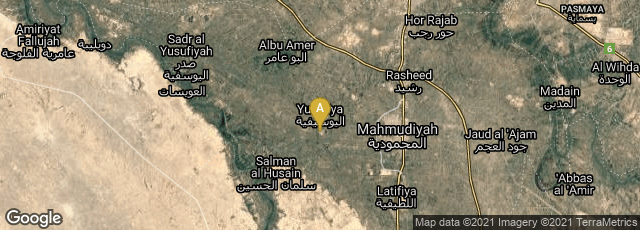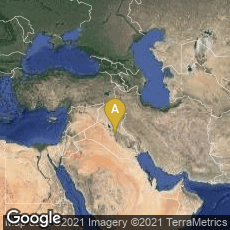

On April 9, 2014, Doyle New York auctioned a Nebuchadnezzar II (Nabu-kudurri-usur) Babylonian cuneiform cylinder that described the rebuilding of the temple of Shamash in Sippar (modern Tell Abu Habbah in Iraq) by Nebuchadnezzar II, and dated to the Neo-Babylonian Period, circa 604-562 BCE. Measuring 8 1/4 inches (20.8 cm) in length, it was the largest example to come to market in recent times. The cylinder was described as, "double-tapered barrel-shaped cylinder of baked clay, 8 1/4 inches (20.8 cm) in length, tapering from 3 1/4 inches (8 cm) at center to 2 1/4 inches (6 cm) at the ends. Text in two columns, approximately 35 lines. Very light wear to the surface but with no apparent loss of legibility; a short and minor fissure, apparently created at the time of forming or firing, visible on a blank area of the cylinder, overall in sound condition."
It was customary for the kings of Babylon to cement their relationship with the gods by restoring their temples. These accomplishments were then recorded in cuneiform on clay cylinders prepared by a court scribe, which were buried in the foundations of the restored temples. The cylinders were enduring commemorations of the king's fealty to the gods. This very public act also helped to create the appearance of legitimacy for the ruler. For example, the Cyrus Cylinder in the British Museum, extols Cyrus as a benefactor. He had attained the throne by deposing the Babylonian king Nabonidus, and he apparently believed that this and similar ritual acts would legitimize his standing with both the gods and his subjects.
The cuneiform cylinder sold by Doyle came from Sippar, a great complex of temples, the cult site of the Akkadian sun god Shamash, and the home of his temple E-babbara. The text was in two columns, and followed text number 16, published both in Babylonian and German, in Langdon, Die neubabylonischen Konigsinschriften (1912) 141 et seq. Berger, in Die neubabylonischen Konigsinchriften (1973) listed seven extant examples of this cylinder, of which five are in the British Museum, and two in the Vorderasiatisches Museum, Berlin. The specimen auctioned by Doyle was slightly larger than any others recorded.
The auction house published this approximate translation of the text of the cylinder:
"Column I.
"NEBUCHADNEZZAR, King of Babylon, the Wise, the Provider, Favorite of Marduk, Sakkanakku of the lands of Sumer and Akkad, who established the foundation of the lands; the Venerated Ruler whom Marduk, the Great Lord, has chosen to renew the Holy Sanctuaries and maintain the cities as his calling: into whose hands Nebo, the Victorious Son gave the scepter of prosperity to extend the lands for Man's guidance; the understanding and reverent, the maintainer of E-sagila and E-zida; the first-born Son of Nabopolassar, King of Babylon am I.
When Marduk, the Great Lord, joyfully created me and called me into the Kingship with an eternal name, I thought reverently of Him and of His Divinity. But I continue humbly to worship Nebo, His legitimate Son, patron of my kingdom; I praise his glory.
I endowed E-Sagila and E-zida, their favored palaces, with gold, silver, precious jewels and tall cedars, and made them shine forth like the innermost heavens. I beautified in splendor the holy sanctuaries of the great Gods, according to the wish of their hearts. E-barra, the radiant abode of the Gods, the dwelling-place of Samas, the Judge, which had long ago fallen into disrepair in Sippar; which no previous king had built, Samas the Lord ordered me, the Ruler, His favorite, to rebuild. I found its old cornerstone, and took notice of it. Over its old cornerstone I laid its foundation. I erected E-barra as it was of yore and completed it. I caused it to shine like the bright day, I caused Samas and Ai to return in gladness and rejoicing to their exalted dwelling. At that time, since time immemorable little had been left at E-ulla, the temple of Ninkarrak in Sippar.
"Column II.
"The temple building was in disrepair, the outer walls had crumbled, the foundation was no longer recognizable; it was buried in the dust; it was no longer numbered among the Holy Sanctuaries of the Gods; the tithes had ceased; they had vanished from the speech of the peoples; the offerings were no longer being made.
Because I held the hem of the garment of Marduk, My Lord, and he was gracious unto me, He entrusted unto my hands the renewal of the Holy Sanctuaries, the restoring of the Edifices.
During my legitimate reign, the merciful Marduk chose to look with favor upon that temple, and Samas, the exalted Judge, ordered its renewal. They ordered me, the shepherd who worships them, to build; I found its old cornerstone and took notice of it. The name of Nikarrak, whose throne is in E-ulla, was inscriped on the image of a dog and was there plainly to be seen. Over the old cornerstone I established the foundation for Ninkarrak, my beloved Mistress, Guardian of my soul, who brings prosperity to my kinsmen; for her I rebuilt E-ulla, her temple in Sippar. Its tithes I enriched and its offerings I restored. O Ninkarrak, Exalted Mistress, look graciously upon the work of my hands. May my acts of devotion be made known to Thy lips. Grant unto me long life, many descendants, good health, and a joyful heart. Present my deeds favorably unto Samas and Marduk; speak in my behalf."
Provenance being essential for the authenticity and title of archaeological artifacts, this cylinder had belonged to Ellen Shaffer, Rare Book Librarian at the Free Library of Philadelphia, and had been sold to Archie P. Johnston in 1953. The hammer price was $500,000, which with the buyer's premium, meant that the price realized was $605,000. This was the highest price realized for a Babylonian Cylinder to date.